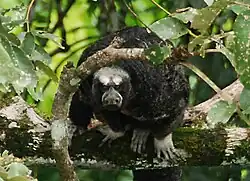Napo saki
| Napo saki[1] | |
|---|---|

| |
| Scientific classification | |
| Kingdom: | Animalia |
| Phylum: | Chordata |
| Class: | Mammalia |
| Order: | Primates |
| Suborder: | Haplorhini |
| Infraorder: | Simiiformes |
| Family: | Pitheciidae |
| Genus: | Pithecia |
| Species: | P. napensis
|
| Binomial name | |
| Pithecia napensis Lönnberg, 1938
| |
The Napo saki (Pithecia napensis), also known as the Napo monk saki,[1] is a species of saki monkey, a type of New World monkey. Its range includes parts of eastern Ecuador and northern Peru.[2] The name is derived from the Napo River in its locality. This species was originally described by Lönnberg as the subspecies Pithecia monachus napensis[2][3] and has been treated as a synonym of P. monachus monachus.[4] Hershkovitz retained it under P. monachus in 1987,[5] but it was raised to full species status in 2014.[2]
References
Wikispecies has information related to Pithecia napensis.
- ^ a b c Marsh, L.K.; de la Torre, S.; Moscoso, P. (2018). "Pithecia napensis". IUCN Red List of Threatened Species. 2018: e.T39955A70609585. doi:10.2305/IUCN.UK.2018-2.RLTS.T39955A70609585.en. Retrieved 19 November 2021.
- ^ a b c Marsh, L. K. (July 2014). "A Taxonomic Revision of the Saki Monkeys, Pithecia Desmarest, 1804". Neotropical Primates. 21 (1): 1–165. doi:10.1896/044.021.0101. S2CID 86516301.
- ^ Groves, C. P. (2005). "Pithecia monachus". In Wilson, D. E.; Reeder, D. M (eds.). Mammal Species of the World: A Taxonomic and Geographic Reference (3rd ed.). Johns Hopkins University Press. pp. 147–148. ISBN 978-0-8018-8221-0. OCLC 62265494.
- ^ Groves, C. P. (2005). "Pithecia monachus monachus". In Wilson, D. E.; Reeder, D. M (eds.). Mammal Species of the World: A Taxonomic and Geographic Reference (3rd ed.). Johns Hopkins University Press. pp. 147–148. ISBN 978-0-8018-8221-0. OCLC 62265494.
- ^ Hershkovitz, P. (1987). "The taxonomy of south American sakis, genus Pithecia (Cebidae, Platyrrhini): A preliminary report and critical review with the description of a new species and a new subspecies". American Journal of Primatology. 12 (4): 387–468. doi:10.1002/ajp.1350120402. PMID 31973491. S2CID 86775905.
